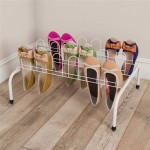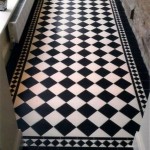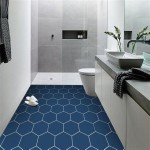Shoe Racks for Closet Floor: A Guide to Organized Footwear Storage
The organization of closet spaces often presents a significant challenge, particularly regarding footwear. Shoes, due to their varied sizes, shapes, and materials, can easily contribute to clutter and disarray. A well-chosen shoe rack designed for closet floor placement provides a practical solution for managing footwear in an efficient and space-saving manner. This article examines the key considerations when selecting a shoe rack for the closet floor, encompassing aspects of material, design, capacity, and suitability for different types of footwear.
Material Considerations for Shoe Racks
The selection of materials for a shoe rack significantly impacts its durability, aesthetics, and overall functionality. Common materials include wood, metal, plastic, and fabric. Each material possesses distinct advantages and disadvantages that should be considered in relation to individual needs and preferences.
Wood: Wooden shoe racks offer a classic and aesthetically pleasing option. They can be constructed from solid wood or engineered wood products like plywood or MDF (Medium-Density Fiberboard). Solid wood racks are generally more durable and resistant to wear and tear, but they also tend to be more expensive. Engineered wood provides a more cost-effective alternative while still offering a reasonable level of durability. Wooden racks can be stained or painted to match the existing décor of the closet. However, wood can be susceptible to moisture damage, so it’s essential to ensure proper ventilation in the closet and avoid storing wet or damp shoes on the rack.
Metal: Metal shoe racks, typically constructed from steel or aluminum, are prized for their strength, durability, and resistance to rust. They often feature a simple, utilitarian design, making them suitable for modern or minimalist closet styles. Metal racks are easy to clean and maintain, and they can withstand heavy use. They are also generally more resistant to mold and mildew growth compared to wooden racks. The open design of many metal racks allows for good air circulation, which helps prevent odors and keeps shoes fresh. However, metal racks may not offer the same aesthetic appeal as wooden racks, and they can sometimes have sharp edges that could potentially damage delicate shoes.
Plastic: Plastic shoe racks are a budget-friendly option that is lightweight, easy to clean, and resistant to moisture. They are available in a wide range of colors and styles, making it easy to find a rack that complements the closet décor. Plastic racks are often modular, allowing for customization to fit specific space requirements. However, plastic racks are generally less durable than wood or metal racks, and they may not be suitable for storing heavy shoes. They also tend to be less aesthetically pleasing compared to other materials.
Fabric: Fabric shoe racks typically consist of a metal frame with shelves made from durable fabric, such as canvas or nylon. These racks are lightweight, easy to assemble, and often collapsible for convenient storage when not in use. Fabric racks are a good option for storing shoes in a guest room or temporary living space. However, fabric shelves may sag over time, especially when storing heavy shoes. They can also be more difficult to clean compared to other materials.
Design Considerations for Closet Floor Shoe Racks
The design of a shoe rack plays a crucial role in its functionality and space efficiency. Various design options cater to different needs and closet configurations. Factors such as the number of shelves, shelf spacing, and overall dimensions should be carefully considered.
Tiered Racks: Tiered shoe racks are a common and versatile design, featuring multiple shelves stacked vertically. This design maximizes vertical space and allows for storing a large number of shoes in a relatively small footprint. Tiered racks are available in various sizes and materials, making it easy to find one that fits the closet space and aesthetic preferences. The number of tiers should be chosen based on the quantity of shoes to be stored and the available vertical space. Adequate spacing between the tiers is essential to accommodate shoes of varying heights, such as boots or high heels.
Expandable Racks: Expandable shoe racks offer flexibility and adaptability, allowing the user to adjust the width of the rack to fit the available space. This design is particularly useful for closets with irregular dimensions or for users who anticipate needing to expand their shoe storage capacity in the future. Expandable racks typically consist of interlocking sections that can be added or removed as needed. They are available in various materials, including metal and plastic.
Stackable Racks: Stackable shoe racks are designed to be stacked on top of each other, creating a modular storage system. This design is ideal for maximizing vertical space and creating a customized shoe storage solution. Stackable racks often feature interlocking mechanisms to ensure stability and prevent them from toppling over. They are available in various materials and sizes, allowing users to create a shoe storage system that meets their specific needs.
Slanted Shelves: Shoe racks with slanted shelves provide better visibility and easier access to shoes. The slanted design allows shoes to be displayed at an angle, making it easier to identify and retrieve the desired pair. This design is particularly useful for users who have a large collection of shoes and want to be able to quickly locate specific pairs. Slanted shelves can be incorporated into tiered racks or wall-mounted shoe organizers.
Under-Shelf Storage: Some shoe racks incorporate under-shelf storage compartments, providing additional space for storing socks, shoe care products, or other small items. This design maximizes the use of available space and helps to keep the closet organized. Under-shelf storage compartments can be drawers, baskets, or open shelves.
Capacity and Footwear Compatibility
The capacity of a shoe rack is a critical consideration, as it determines the number of shoes that can be stored. It is important to accurately assess the size of the shoe collection and select a rack that can accommodate it. Furthermore, the design of the rack should be compatible with different types of footwear, including sneakers, sandals, heels, and boots.
Determining Capacity Needs: Before purchasing a shoe rack, it is essential to take inventory of the entire shoe collection. This includes counting the number of pairs of shoes and assessing the space required for each pair. Consider seasonal variations in shoe usage, as some shoes may only be worn during certain times of the year. It is generally advisable to select a rack with slightly more capacity than currently needed to accommodate future additions to the shoe collection. Also, consider if each shoe must have its distinct space or can be paired and stacked.
Accommodating Different Shoe Types: Different types of footwear require different amounts of storage space. Sneakers and sandals typically take up less space than boots or high heels. When selecting a shoe rack, it is important to consider the proportion of different shoe types in the collection. A rack with adjustable shelves or compartments can be particularly useful for accommodating footwear of varying heights. For example, a rack with taller shelves can be used to store boots, while shorter shelves can be used to store sneakers or sandals.
Boot Storage Solutions: Boots, due to their height and bulk, often present a storage challenge. Dedicated boot racks or organizers can help to prevent boots from slouching or creasing. These racks typically feature tall shelves or hanging hooks that support the boot shafts. Alternatively, boot shapers can be used to maintain the shape of the boots when they are stored on a standard shoe rack.
Heel Storage Considerations: High heels can also be challenging to store, as their pointed heels can damage other shoes or snag on fabric shelves. Special heel organizers or racks with individual slots for each heel can help to protect the shoes and keep them organized. Alternatively, heels can be stored on a shoe rack with a solid surface to prevent the heels from damaging other items.
Ultimately, the choice of a shoe rack for the closet floor hinges on a careful evaluation of personal needs, closet space constraints, and aesthetic preferences. A well-considered selection will contribute significantly to a more organized and functional closet space.

Say Goodbye To Shoe Overload In Maple Valley And More Of Wa

Floor To Ceiling Shoe Shelves Design Ideas

Aooda 3 Tier Long Shoe Rack For Closet Stackable Wide Shelf Organizer And Storage Floor Entryway Broe Artbeek

Odoroku 3 5 7 Tiers Stackable Shoe Rack For Closet Plastic Tower Sneaker Space Saving Storage Organizer Large Shelf Holder Stand

Floor To Ceiling Shoe Shelves Design Ideas

Satrino Long 2 Tier Shoe Rack For Closet Metal Wide Stackable Storage Organizer Entryway Bedroom Floor 18 Pairs Low Shelf Black

Floor To Ceiling Shoe Shelves Design Ideas

Closetmaid Shelftrack 11 25 In D X 36 W 4 H 5 Pair Ventilated Wire Shoe Shelf Steel Closet System 2846
Shoe Rack Indoor Ironwork Multi Layer Floor Standing Shelf Bto Storage Easy

Multi Layer Shoe Rack Storage Single Row Free Temu Germany







